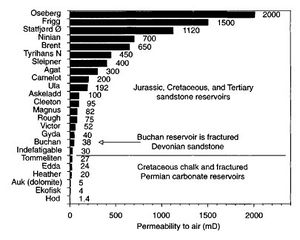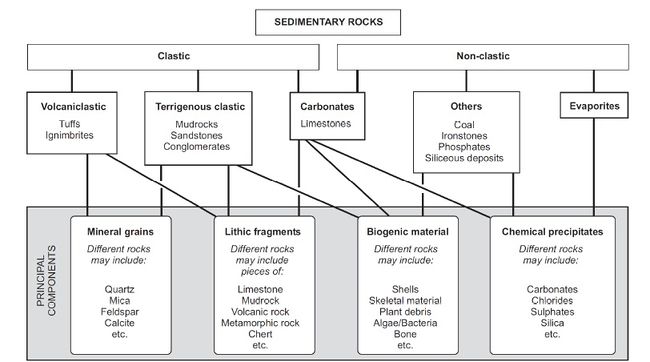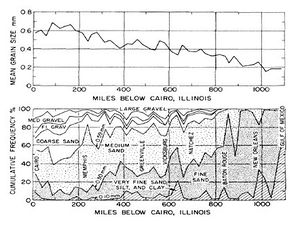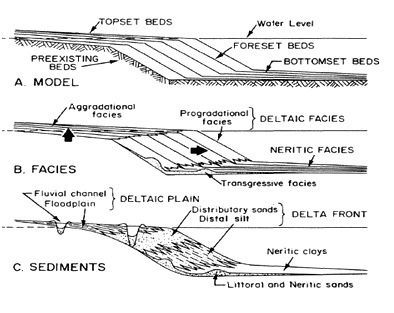Reservoir
| Wiki Write-Off Entry | |
|---|---|

| |
| Student Chapter | University of Brawijaya |
| Competition | June 2015 |
Reservoir rocks are rocks that have the ability to store fluids inside their pores, so that the fluids (water, oil, and gas) can be accumulated. In petroleum geology, reservoir is one of the elements of petroleum system that can accumulate hydrocarbons (oil or gas). Reservoir rock must have good porosity and permeability to accumulate and drain oil in economical quantities.
Reservoir Porosity
Porosity is the void space in a rock that can store the fluids. It is measured as either a volume percentage or a fraction (expressed as a decimal). In the subsurface this volume may be filled with petroleum (oil and gas), water, a range of non hydrocarbon gasses (CO2, H2S, N2), or some combination of these.[1]
Porosity is symbolized in phi (ϕ) and its value is expressed in percentage. Porosity value calculation:
Porosity divided into two types, absolute porosity and effective porosity. Absolute porosity is the ratio of the total pore volume in the rock to bulk volume, obtained by the calculation:
Effective porosity is the ratio of interconnected pore volume to bulk volume, obtained by calculation:
Based on the way of its formation, there are two types of porosity:
- Primary porosity is porosity that formed while sedimentary rock deposited.
- Secondary porosity is porosity that formed after the sedimentary rock deposited.
Reservoir Permeability
Permeability is an intrinsic property of a material that determines how easily a fluid can pass through it. In the petroleum industry, the Darcy (D) is the standard unit of permeability, but milidarcies (1 mD = 10-3 D) are more commonly used. A Darcy is defined as a flow rate of 10-2 ms-1 for a fluid of 1 cp (centipoise) under a pressure of 10-4atm m-2. Permeability in reservoir rocks may range from 0.1 mD to more than 10 D.[1]
Type of Reservoir Rocks
All types of rock (igneous, sedimentary, metamorphic) can act as reservoir rocks if it can accommodate and drain hydrocarbons. Reservoir rocks around the world is dominated by sedimentary rocks because generally it has primary porosity. Igneous and metamorphic rocks can be reservoir if there are in fracturing state (secondary porosity).
Siliciclastic Reservoir
Siliciclastic sedimentary rocks are the most abundant of the sedimentary rock. They are formed from the detritus left over from the weathering of igneous, metamorphic, and older sedimentary rocks.[8]
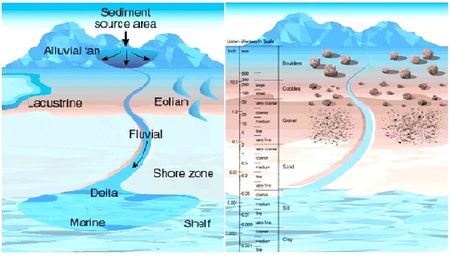
Shallow and Deep Marine Reservoir
Depending on the type of sedimentary rock, hydrocarbon reservoir can be divided into two groups. There are clastic sedimentary rock and non clastic sedimentary rock. On the clastic sedimentary, contained some precipitation area, as one in marine area. Rock type can be formed in deposition marine areas such as shelf sandstone and turbidity sandstone.
Shelf sandstones are formed from precipitating in the shallow marine area. Sands transported by water current from river to shallow marine area. Because of that process, has been formed sands body around the grow delta and maybe form the fan like in delta.
Turbidity sandstones: rock formed in deep marine area with rotation force existing rotation deep current so as formed the coarse layer which has interaction with shale layer in the deep marine. Shape from deposition of turbidity sandstones can be like a lens, duct, or fans.
Lacustrine Reservoir
This type of reservoir formed in basin containing water surrounded by land and initially formed by tectonic processes, volcanic, rifting, soil movement, the erosion by the wind on the coast or in land. The texture of sedimentary rocks in the environments usually granules grained and the size between 2 mm–4 mm.
Eolian Reservoir
Formed in large areas with the accumulation of sand deposition. The sediment resulting from wind-blown sand. The clastic texture of the environment is granules (2–4 mm) and coarse (over 2 mm; Table 1).
| Name | Morphology | No. of Slipfaces | Wind Direction | Sand Supply (relative) | Relative Size |
|---|---|---|---|---|---|
| Sheet | Sheetlike with broad flat surface | None | Multidirectional | Abundant | Large, thick |
| Stringer | Thin, elongate strip | None | Unidirectional | Sparse | Extensive, thin |
| Dome | Circular or elliptical mound | None | Bidirectional | Sparse | Small, thin |
| Barchan | Crescent | 1 | Unidirectional | Sparse | Small, thin |
| Barchanoid ridge | Row of connected crescents | 1 | Unidirectional | Abundant | Large, thick |
| Transverse ridge | Asymmetrical ridge | 1 | Unidirectional | Very abundant | Large, thick |
| Parabolic | U-shape | 1 or more | Unidirectional | Abundant | Large, thick |
| Linear (seif) | Symmetrical ridge | 2 | Bidirectional | Sparse | Extensive, thin |
| Reversing | Asymmetrical ridge | 2 | Bidirectional | Small, thin | |
| Star | Central peak with 3 or more arms | 3 or more | Multidirectional | Sparse | Small, thin |
| Blowout | Circular rim of depression | 1 or more | Multidirectional | Variable | Small |
Fluvial Reservoir
Type reservoir generated by the flow of the river where the process is formed by the erosion, transport and deposition of forming depositional formation.
Deltaic Reservoir
On this type of reservoir, it was formed by the accumulation of lacustrine sediments. Very fine grain sediment rocks.
Carbonate Reservoir
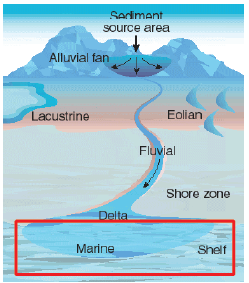
Carbonate rocks is a sedimentary rocks with carbonate fraction more than 50%. Carbonate rocks can be used as a reservoir because of its porosity and permeability. Carbonate rocks can be classified to clastic and non clastic sediment. Its environmental formation is tropic ocean. The porosity concept of a carbonate rock might be a little bit more complex than other rocks, because of its vary secondary porous, from carbonate dissolution made from skeletal remain and microbe with cement. Almost all of carbonate reservoir type accumulated as a shallow marine sedimentary, except on a pelagic chalk and deep marine re-sediment reservoir carbonate in Mexico seas. Carbonate reservoir rocks can be found as a clastic limestone, carbonate framework (reef), and dolomite.
Reef Reservoir
Reef is a framework made of sea organism containing skeletal, grow in a shallow clean water where sunlight can reach as a nutrition. Reef distribution is varies, some on the edge of the shelf and become a barrier, some scattered called patch reef. Patch reef can reach a few kilometer size while barrier can be elongated along the edge and limit the exposure with basin. Meanwhile the shape of a reef can be a pole(pinnacle) or lengthened (fringing). Both can become a good reservoir. Reef is a non-clastic carbonate rocks without transportation process on its formation.
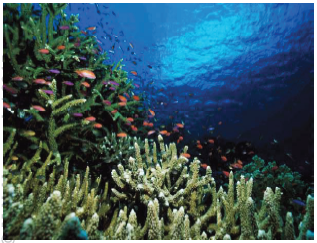
Clastic Limestone
Clastic limestone usually associated with oolit and become a pretty good reservoir. Limestone associated with oolite often referred to as calcarenite. The deposition is in shallow marine environments along the coast with high energy (strong wave currents). Porosity may be extremely high because of the dissolution, but permeability is not far from 5 mD. It is called clastic because oolite associated with limestone is present through the transport process before finally being deposited.
Dolomite
Dolomite formed by processes of calcite dolomitization from other carbonates (e.g. limestone). Dolomitization occurred not long after the process of sedimentation. Dolomitization process can be reviewed as the secretion of magnesium contained in sea water into the compounds associated with carbonate.Dolomite production begins from the Pre-Cambrium, continued from Paleozoic to Mesozoic, up to Tertiary time. Calcite will be replaced with the dolomite compound that has smaller volume, so that the space between the pores of the rock grew wide. This resulted in the cavities. Calcite that has not been dolomitized will dissolve quickly and arising secondary pores, sometimes with very large size. Dolomite has its price of porosity as high as limestone porosity, which is about 20-30%. However, permeability is very high, reaching up to 5 mill Darcy to 2 Darcy. Hence, dolomite carbonate reservoirs have higher production of hydrocarbon than limestone. According Zenger (1980) estimates that 80% of carbonate reservoirs in the USA contains dolomite, while the 20% rest of it contains limestone.
Afanitic Limestone
Afanitic limestone formed in shallow ocean areas with low levels of energy, such as for example in the lagoon. This limestone has a very fine grain size and tight. However, the porosity and permeability was appeared by the events of dissolution and cracking that causing this type of limestone have secondary porosity. Thus, it can be a reservoir of oil.
Another Type of Reservoir
Although the porosity and permeability are poor, shale, silt stone, limestone can even act as reservoir due to fractures in the rock body (secondary porosity – secondary permeability). For example, an oil field in Florence, Colorado which is having shale (Lower–Upper Cretaceous) as reservoir rock.
Then, it shows that for other than sedimentary rocks (igneous – metamorphic) could be reservoir rock if there are in fracturing state. For example, in Cuba, the oil is obtained from ultra-base igneous rock or volcanic rock that has fractured. There are eight oil fields in Cuba in 1964 that produce 710 barrels oil per day.[13] Reservoir from this type has a very small percentage compared to the reservoir from sedimentary rock (about 1% of the overall reservoir in the world).
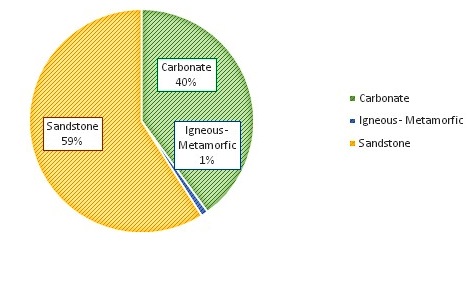
Volcanic rocks are igneous rocks that formed on the earth surface (extrusive igneous rock). Volcanic rock can be formed from mafic minerals such as olivine, pyroxene, amphibole, and biotite, or felsic minerals such as feldspar, muscovite, and quartz.[15] For example, oil obtained in Jatibarang (West Java, Indonesia), produced from fractures that occur in volcanic rock (tuff). Oil production from volcanic rock reservoir shows higher production in initially, and then shows a rapid decline in production.
References
- ↑ 1.0 1.1 1.2 Gluyas, J., and S. Richard, 2004, Petroleum Geoscience: Blackwell Science Ltd.
- ↑ Spencer, S. J., M. L. Somers, W. V. Pinczewski, and I. D. Doig, 1987, Numerical simulation of gas drainage from coal seams: SPE Paper 16857, 1987 SPE Annual Technical Conference and Exhibition, Dallas, Texas, p. 27-30.
- ↑ Abbots, I. L., ed., United Kingdom Oil and Gas Fields, 25 Years Commemorative Volume: Geological Society (London) Memoir 14
- ↑ Gluyas, J. G., S. M. Grant, and A. G. Robinson, 1993, Geochemical evidence for a temporal control on sandstone cementation, in A. D. Horbury and A. G. Robinson, eds., Diagenesis and basin development: AAPG Studies in Geology 36, p. 23-34.
- ↑ H. N. Oxtoby, W. A. Mitchell, and J. Gluyas, 1995, The filling and emptying of the Ula oilfield (Norwegian North Sea), in J. M. Cubitt and W. A. England, eds., The geochemistry of reservoirs: Geological Society (London), p. 141-158
- ↑ Nichols, G., 2009, Sedimentology and Stratigraphy. Blackwell Science Ltd., London, 335 p.
- ↑ 7.0 7.1 7.2 Alamsyah, M.N., 2015, Konsep Petroleum System (Handout Kuliah): Universitas Brawijaya
- ↑ Klein, C., and A.R. Philpotts, 2013, Earth Materials: Introduction to Mineralogy and Petrology, Cambridge University Press.
- ↑ http://www.glossary.oilfield.slb.com
- ↑ Gilbert, G. K., 1885, The topographic features of lake shores: U.S. Geological Survey Annual Report 5, p. 75– 123.
- ↑ Frazier, D. E., 1967, Recent deltaic deposits of the Mississippi River; their development and chronology: Gulf Coast Association of Geological Societies Transactions, v.17, p. 287-315
- ↑ Berg, R. R., 1985, Reservoir Sandstones: Prentice Hall College Div.
- ↑ Koesoemadinata, R. P., 1980, Geologi Minyak: Dan Gasbumi, Institut Teknologi Bandung.
- ↑ Knebel, G. M., and G. Rodriguez-Eraso, 1956, Habitat of some oil: AAPG Bulletin, v. 40, no. 4, p. 547-561
- ↑ Noor, D., 2009, Pengantar Geologi, Universitas Pakuan Bogor.
Other sources
- Baganz, O. W., B. Yuval, B. Kevin, and N. Dag, 2012, Lacustrine Sandstone Reservoirs and Hydrocarbon Systems: AAPG Memoir 95.
- Ehrenberg, S. N., and P. H. Nadeau, 2005, Sandstone vs. Carbonate Petroleum Reservoirs: A Global Perspective on Porosity-depth and Porosity-Permeability Relationships: AAPG Bulletin vol. 89, pp. 435-445.



